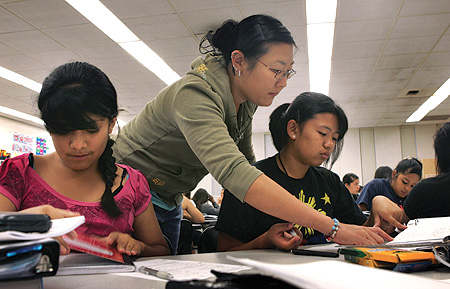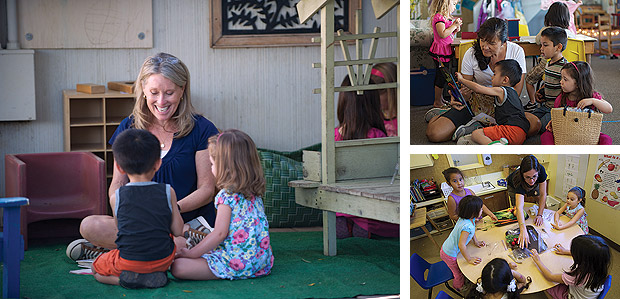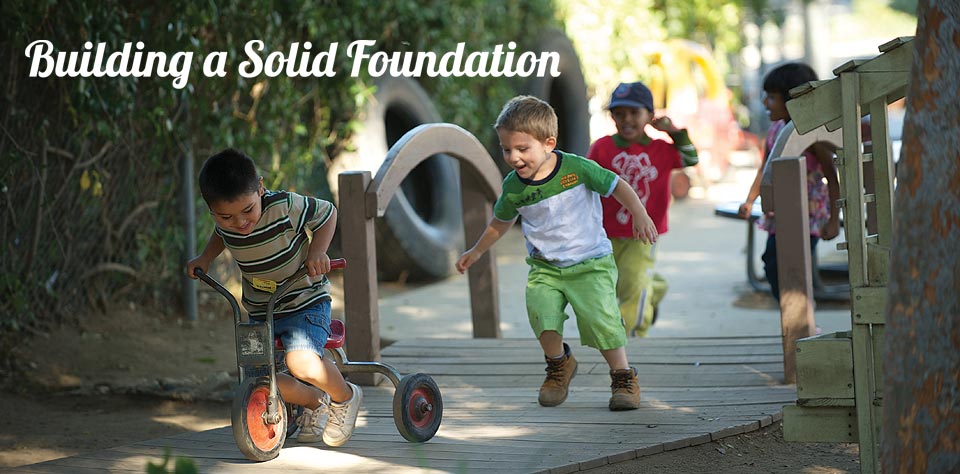Diverse Children's Programs Empower Tomorrow's Students
President John F. Kennedy once said that children are the world’s most valuable resource and its best hope for the future. Cal State Fullerton is committed to nurturing that resource and offers an array of educational and developmental programs designed to enrich the lives of local youth, as well as to support the members of our campus community in their multiple roles as students, parents, tutors and volunteers.
There is a spot on the north end of campus where the kids sport coloring books instead of laptops and carry their gear in Elmo backpacks. Their “quad” contains a jumble of brightly colored climbing equipment, and instead of desks, the teachers roll out spongy mats at nap time.
Welcome to the Children’s Center, where Cal State Fullerton’s youngest students paint, sing and play their way to a solid foundation in the ABCs of early childhood learning.
“Play is so important,” explained Children’s Center Director Betsy Gibbs. “Play is the way kids figure things out. It’s the way they interact with each other, and it’s the way they experience how things work, so putting together an environment which encourages different kinds of play is important.”
The Children’s Center serves up to 90 children who range from infants to 5-year-olds. “Our main focus is the development of communication skills,” Gibbs said. “We want kids to be able to say what they feel, what they think, what they want, and help them through social interactions so they learn how to negotiate with other kids.”
Established in 1971 by Associated Students Inc., the center serves children whose parents are CSUF students, as well as children of university faculty and staff members. ASI underwrites the costs of the program, which also receives funding from U.S. and California departments of education.
Project MISS (Mathematics Intensive Summer Session)
Across campus, 15-year-old Ana Arellano is on a mission to master math.
While other girls are spending their summers at the beach or playing video games, Arellano is solving algebra equations with 19 other ninth- and 10th-grade girls. They are part of Project MISS, a four-week program that assists collegebound high school girls who are struggling in math.
“Math has always been a huge problem for me,” said Arellano, a sophomore at Valencia High School in Placentia. “This is an opportunity for me to spend my time learning math, not having to focus on history and science.”
Project MISS is the brainchild of Mathematics Professor David Pagni, who launched the program in 1990 in response to a nationwide shortage of young people opting for careers in the STEM fields: science, technology, engineering and mathematics.
MISS targets minority females who are motivated to attend college; many, like Arellano, will be the first in their families to do so.
“If we have a student who wants to go to college and is doing well in classes, but struggling in math, that’s our model,” Pagni explained. “We help them meet their goal by making them 13 successful in algebra II.”
Much of that success comes from gaining confidence and learning to work as a team. Students work in groups of four, chosen according to pre-test scores. Instructors and tutors – all female – involve them in a variety of fun, hands-on activities, including creating team logos and “math girl” posters, solving humorous story problems, and participating in a scavenger hunt around campus.
“We play a lot of games where they can talk about their lives, about things that make them laugh,” explained Neha Arora, who participated in the MISS program as a student in 2002 and returned last year as a tutor. “I feel like the more they laugh, the better the experience they’ll have and the more they’ll remember about this program.”
MISS participants are selected from about 15 area high schools. Between 1990 and 2009, 865 girls completed the program. Pagni estimates 95 percent have gone to college, with about 20 percent entering STEM majors.
 Maria Serratos, left, and Janel De Guzman, right,
learn about angles and arcs from Project MISS instructor
Candice Harrington, who completed her CSUF teaching
credential in May 2010.
Maria Serratos, left, and Janel De Guzman, right,
learn about angles and arcs from Project MISS instructor
Candice Harrington, who completed her CSUF teaching
credential in May 2010.
Engineering Innovations
What can you do with a pound of spaghetti and a jar of epoxy? Build a bridge, of course! That’s what a group of talented high school students did last summer as part of Engineering Innovations, one of CSUF’s newest kid-centered programs.
For the first time, the College of Engineering and Computer Science partnered with Johns Hopkins University to offer this intensive four-week course that teaches ninth- through 12th-graders to think and problem-solve like engineers. Students who complete the program earn three transferable college credits.
“We’re hoping that this will increase the number of students pursuing degrees in engineering,” said Victor Delgado, assistant dean of the college, who noted that this is the only program of its kind locally. “We find that students don’t always think about engineering or have an idea what it takes. This gives them an idea in high school.”
Hands-on projects include designing and building mousetraps, digital circuits and robotic cars. The culmination of the course is a spirited competition before parents and peers to see whose spaghetti bridge supports the most weight.
Center for Children Who Stutter
Winston Churchill stuttered and so did Tiger Woods. In fact, an estimated three million Americans suffer from this speech disorder.
Located within the Speech and Hearing Center, the Center for Children Who Stutter provides diagnosis, prevention, treatment and community education, touching some 1,000 families each year.
“Not only are the kids that we’re serving here getting help, but so are the families we counsel over the phone,” said Center Director Sherri Wolff. “Additionally, we have a yearly conference, so the pathologists that attend can use that information with families they work with.”
Founded in 1995 by Professors Glyndon and Jeanna Riley, the center is funded by fees for services (based on ability to pay) as well as fundraising. Many of the children being treated are on scholarships.
Under supervision, graduate students in the field of communication disorders gain experience by providing assessment and therapy to the clients.
With therapy, Wolff said recovery rates can be as high as 80 percent. “Early intervention is the key,” she explained. “If we can get them in as early as possible, the outcome is usually better.”
 With their main focus the development of communication skills, three teachers
address students at the CSUF Children’s Center. Above, Assistant Director Bev
Vargish works with two pupils. At top right, Cathy Higa, master teacher, tells stories to a small group. At bottom right, intern Jackie James teaches students about vegetables and nutrition.
With their main focus the development of communication skills, three teachers
address students at the CSUF Children’s Center. Above, Assistant Director Bev
Vargish works with two pupils. At top right, Cathy Higa, master teacher, tells stories to a small group. At bottom right, intern Jackie James teaches students about vegetables and nutrition.
GEAR UP (Gaining Early Awareness and Readiness for Undergraduate Programs)
Greg Davenport has a zeal for helping kids. For the past two years, the human services major has spent Saturdays tutoring junior high school students as part of a federally funded program that prepares at-risk youth for college.
Launched in 2008 with a $7.89-million grant, GEAR UP is a six-year cohort program that follows some 1,900 students as they progress from seventh through 12th grade. The program began at Sycamore and South junior high schools in Anaheim and has moved on to Katella, Loara and Anaheim high schools.
“Right now in the Anaheim area, kids drop out of high school all the time,” Davenport said. “We tell these kids that college is important, and we need to be sure that you can graduate, so we’re here to help you.”
GEAR UP employs about 50 trained CSUF students as in-class and after-school tutors in math, English and science. Outside activities include trips to college campuses, the Griffith Observatory and the Ocean Institute. Additionally, the program offers professional-development training for teachers, facilitated by CSUF faculty.
“The overall goal is to prepare students with the choice to go to college and to make sure they’re prepared to enter and be successful once they leave high school,” said Mark Kamimura-Jimenez, director of educational partnerships. “Our personal goal is to get every kid to go to college.” ![]()

